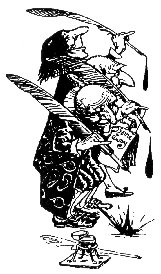September 3, 2006
Op-Ed Columnist
Donald Rumsfeld’s Dance With the Nazis
By FRANK RICH
PRESIDENT BUSH came to Washington vowing to be a uniter, not a divider. Well, you win some and you lose some. But there is one member of his administration who has not broken that promise: Donald Rumsfeld. With indefatigable brio, he has long since united Democrats, Republicans, generals and civilians alike in calling for his scalp.
Last week the man who gave us “stuff happens” and “you go to war with the Army you have” outdid himself. In an instantly infamous address to the American Legion, he likened critics of the Iraq debacle to those who “ridiculed or ignored” the rise of the Nazis in the 1930’s and tried to appease Hitler. Such Americans, he said, suffer from a “moral or intellectual confusion” and fail to recognize the “new type of fascism” represented by terrorists. Presumably he was not only describing the usual array of “Defeatocrats” but also the first President Bush, who had already been implicitly tarred as an appeaser by Tony Snow last month for failing to knock out Saddam in 1991.
What made Mr. Rumsfeld’s speech noteworthy wasn’t its toxic effort to impugn the patriotism of administration critics by conflating dissent on Iraq with cut-and-run surrender and incipient treason. That’s old news. No, what made Mr. Rumsfeld’s performance special was the preview it offered of the ambitious propaganda campaign planned between now and Election Day. An on-the-ropes White House plans to stop at nothing when rewriting its record of defeat (not to be confused with defeatism) in a war that has now lasted longer than America’s fight against the actual Nazis in World War II.
Here’s how brazen Mr. Rumsfeld was when he invoked Hitler’s appeasers to score his cheap points: Since Hitler was photographed warmly shaking Neville Chamberlain’s hand at Munich in 1938, the only image that comes close to matching it in epochal obsequiousness is the December 1983 photograph of Mr. Rumsfeld himself in Baghdad, warmly shaking the hand of Saddam Hussein in full fascist regalia. Is the defense secretary so self-deluded that he thought no one would remember a picture so easily Googled on the Web? Or worse, is he just too shameless to care?
Mr. Rumsfeld didn’t go to Baghdad in 1983 to tour the museum. Then a private citizen, he had been dispatched as an emissary by the Reagan administration, which sought to align itself with Iraq in the Iran-Iraq war. Saddam was already a notorious thug. Well before Mr. Rumsfeld’s trip, Amnesty International had reported the dictator’s use of torture — “beating, burning, sexual abuse and the infliction of electric shocks” — on hundreds of political prisoners. Dozens more had been summarily executed or had “disappeared.” American intelligence agencies knew that Saddam had used chemical weapons to gas both Iraqi Kurds and Iranians.
According to declassified State Department memos detailing Mr. Rumsfeld’s Baghdad meetings, the American visitor never raised the subject of these crimes with his host. (Mr. Rumsfeld has since claimed otherwise, but that is not supported by the documents, which can be viewed online at George Washington University’s National Security Archive.) Within a year of his visit, the American mission was accomplished: Iraq and the United States resumed diplomatic relations for the first time since Iraq had severed them in 1967 in protest of American backing of Israel in the Six-Day War.
In his speech last week, Mr. Rumsfeld paraphrased Winston Churchill: Appeasing tyrants is “a bit like feeding a crocodile, hoping it would eat you last.” He can quote Churchill all he wants, but if he wants to self-righteously use that argument to smear others, the record shows that Mr. Rumsfeld cozied up to the crocodile of Baghdad as smarmily as anyone. To borrow the defense secretary’s own formulation, he suffers from moral confusion about Saddam.
Mr. Rumsfeld also suffers from intellectual confusion about terrorism. He might not have appeased Al Qaeda but he certainly enabled it. Like Chamberlain, he didn’t recognize the severity of the looming threat until it was too late. Had he done so, maybe his boss would not have blown off intelligence about imminent Qaeda attacks while on siesta in Crawford.
For further proof, read the address Mr. Rumsfeld gave to Pentagon workers on Sept. 10, 2001 — a policy manifesto he regarded as sufficiently important, James Bamford reminds us in his book “A Pretext to War,” that it was disseminated to the press. “The topic today is an adversary that poses a threat, a serious threat, to the security of the United States of America” is how the defense secretary began. He then went on to explain that this adversary “crushes new ideas” with “brutal consistency” and “disrupts the defense of the United States.” It is a foe “more subtle and implacable” than the former Soviet Union, he continued, stronger and larger and “closer to home” than “the last decrepit dictators of the world.”
And who might this ominous enemy be? Of that, Mr. Rumsfeld was as certain as he would later be about troop strength in Iraq: “the Pentagon bureaucracy.” In love with the sound of his own voice, he blathered on for almost 4,000 words while Mohamed Atta and the 18 other hijackers fanned out to American airports.
Three months later, Mr. Rumsfeld would still be asleep at the switch, as his war command refused to heed the urgent request by American officers on the ground for the additional troops needed to capture Osama bin Laden when he was cornered in Tora Bora. What would follow in Iraq was also more Chamberlain than Churchill. By failing to secure and rebuild the country after the invasion, he created a terrorist haven where none had been before.
That last story is seeping out in ever more incriminating detail, thanks to well-sourced chronicles like “Fiasco,” “Cobra II” and “Blood Money,” T. Christian Miller’s new account of the billions of dollars squandered and stolen in Iraq reconstruction. Still, Americans have notoriously short memories. The White House hopes that by Election Day it can induce amnesia about its failures in the Middle East as deftly as Mr. Rumsfeld (with an assist from John Mark Karr) helped upstage first-anniversary remembrances of Katrina.
One obstacle is that White House allies, not just Democrats, are sounding the alarm about Iraq. In recent weeks, prominent conservatives, some still war supporters and some not, have steadily broached the dread word Vietnam: Chuck Hagel, William F. Buckley Jr. and the columnists Rich Lowry and Max Boot. A George Will column critical of the war so rattled the White House that it had a flunky release a public 2,400-word response notable for its incoherence.
If even some conservatives are making accurate analogies between Vietnam and Iraq, one way for the administration to drown them out is to step up false historical analogies of its own, like Mr. Rumsfeld’s. In the past the administration has been big on comparisons between Iraq and the American Revolution — the defense secretary once likened “the snows of Valley Forge” to “the sandstorms of central Iraq” — but lately the White House vogue has been for “Islamo-fascism,” which it sees as another rhetorical means to retrofit Iraq to the more salable template of World War II.
“Islamo-fascism” certainly sounds more impressive than such tired buzzwords as “Plan for Victory” or “Stay the Course.” And it serves as a handy substitute for “As the Iraqis stand up, we’ll stand down.” That slogan had to be retired abruptly last month after The New York Times reported that violence in Baghdad has statistically increased rather than decreased as American troops handed over responsibilities to Iraqis. Yet the term “Islamo-fascists,” like the bygone “evildoers,” is less telling as a description of the enemy than as a window into the administration’s continued confusion about exactly who the enemy is. As the writer Katha Pollitt asks in The Nation, “Who are the ‘Islamo-fascists’ in Saudi Arabia — the current regime or its religious-fanatical opponents?”
Next up is the parade of presidential speeches culminating in what The Washington Post describes as “a whirlwind tour of the Sept. 11 attack sites”: All Fascism All the Time. In his opening salvo, delivered on Thursday to the same American Legion convention that cheered Mr. Rumsfeld, Mr. Bush worked in the Nazis and Communists and compared battles in Iraq to Omaha Beach and Guadalcanal. He once more interchanged the terrorists who struck the World Trade Center with car bombers in Baghdad, calling them all part of the same epic “ideological struggle of the 21st century.” One more drop in the polls, and he may yet rebrand this mess War of the Worlds.
“Iraq is not overwhelmed by foreign terrorists,” said the congressman John Murtha in succinct rebuttal to the president’s speech. “It is overwhelmed by Iraqis fighting Iraqis.” And with Americans caught in the middle. If we owe anything to those who died on 9/11, it is that we not forget how the administration diverted our blood and treasure from the battle against bin Laden and other stateless Islamic terrorists, fascist or whatever, to this quagmire in a country that did not attack us on 9/11. The number of American dead in Iraq — now more than 2,600 — is inexorably approaching the death toll of that Tuesday morning five years ago.










